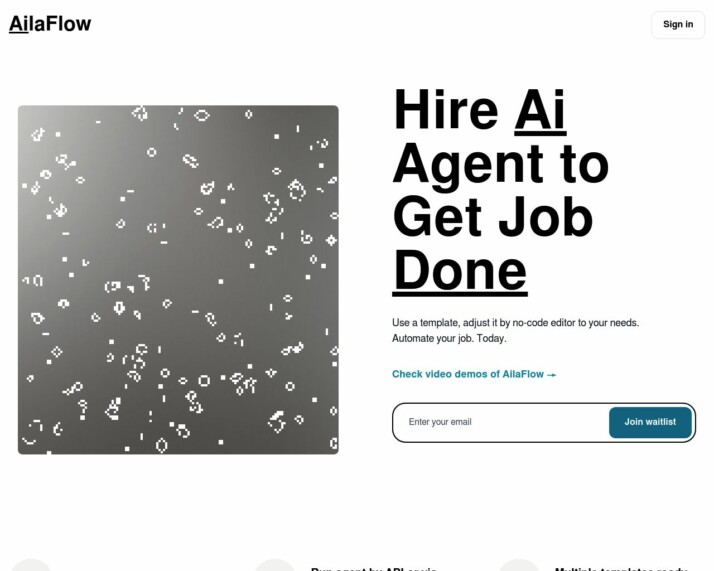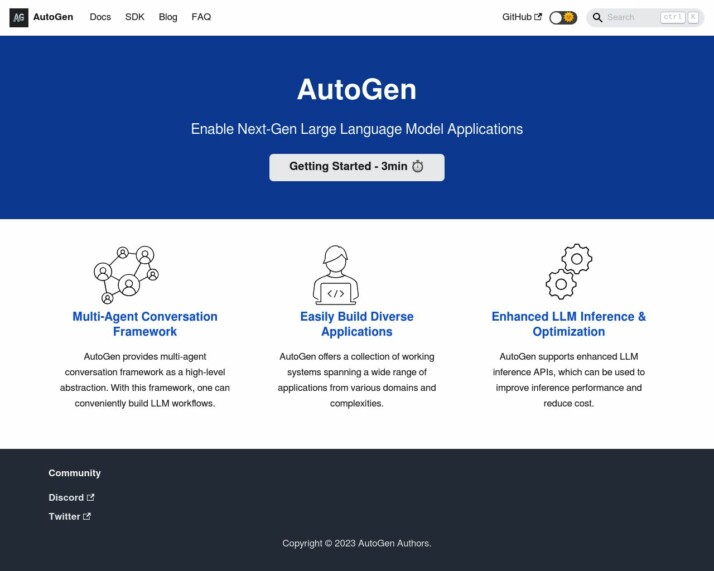Introduction
In this article, we will introduce AilaFlow and AutoGen, two powerful frameworks designed for developing Large Language Model (LLM) applications. We will also provide a comparison between the two, highlighting their unique features and applications. If you’re a software developer, project manager, startup, technology company, or AI enthusiast, this article is for you. We will delve into the capabilities of each framework, addressing the challenges in software development, project management, and AI-driven automation.
Let’s start by exploring AutoGen, a sophisticated framework that allows you to develop LLM applications using multi-agent conversations. AutoGen stands out with its ability to facilitate conversations between multiple agents, empowering them to perform tasks autonomously or with human feedback. It also maximizes the performance of LLMs like ChatGPT and GPT-4 through enhanced inference capabilities.
With AutoGen, you can customize and converse with agents, integrating LLMs, human inputs, and various tools. Whether you’re looking to automate complex tasks, engage in innovative problem-solving, or enhance your existing AI capabilities, AutoGen provides a versatile tool in the realm of conversational AI and LLM applications.
On the other hand, AilaFlow offers a no-code platform for building AI agents with ease of use and versatility in mind. With AilaFlow, you can create and manage AI agents without the need to code, making it accessible for non-technical users. The platform features a sequential workflow designer that allows you to create various applications using graphical programming languages, workflow builders, and sequence diagram editors.
Additionally, AilaFlow provides customization options, compatibility with different frameworks, and a user-friendly interface. It aims to democratize the creation of AI agents, making AI development accessible to a wider audience.
Throughout this article, we’ll explore the features, target audience, and unique offerings of both AilaFlow and AutoGen. By the end, you’ll have a clear understanding of which framework best suits your needs and goals. So, let’s dive in and discover the world of AilaFlow and AutoGen!
An Overview of AilaFlow
AilaFlow is a distinctive offering in the Artificial Intelligence (AI) landscape. It is a no-code platform, allowing users to build and adjust AI agents without requiring advanced programming knowledge. Its unique selling point lies in its emphasis on ease of use and versatility.


The AilaFlow offering is designed to serve a varied target audience, ranging from non-technical users and business professionals to educators, students, small to medium enterprises (SMEs), and even AI enthusiasts. Its no-code platform and sequential workflow designer tool make AI and workflow automation accessible to a wider audience. This tool is unique to the AilaFlow specialties as it has zero external dependencies and supports several popular frameworks including Angular, React, and Svelte.
The recent releases of AilaFlow include hosting services for AI agents and autonomous functionality. They focus on making human-AI interactions efficient, leveraging foundational AI models like the Large Language Model (LLM) to streamline business processes. Emphasizing security in live operations, AilaFlow targets enhancing efficiency and decision-making in various business contexts.
AilaFlow applications are adaptable due to the platform’s customization and configuration capabilities, appealing to a broad audience. These include distinctive features and flexibility in various development environments. The platform embodies AilaFlow’s vision by making AI agents’ creation an accessible tool for anyone, regardless of their technical proficiency.
In a nutshell, AilaFlow’s features and benefits include a user-friendly platform for building AI agents, compatibility with various frameworks and devices, and tools for customization and ease of use. This platform democratizes the creation and management of AI agents, making AI technology adaptive and accessible to a wider audience.
Overview of AutoGen


AutoGen is a sophisticated framework designed to develop Large Language Model (LLM) applications using multi-agent conversations. This unique approach allows customizable and conversable agents to interact with each other, LLMs, tools, and humans to solve various tasks. Some standout features of AutoGen include:
- Multi-Agent Conversations: AutoGen facilitates conversations between multiple agents, enabling them to collectively perform tasks autonomously or with human feedback, making it highly adaptable for different use cases.
- Enhanced LLM Inference: The framework maximizes the performance of LLMs like ChatGPT and GPT-4 by offering enhanced inference capabilities. This includes functionalities like tuning, caching, error handling, and templating, crucial for optimizing the utility of expensive LLMs.
- Customizable and Conversable Agents: Agents in AutoGen are not only conversable but also customizable. This allows developers to tailor the agents according to the specific needs of the task, integrating LLMs, human inputs, and various tools.
- Autonomous Operations with Human Feedback: AutoGen supports both fully autonomous agent operations and human-in-the-loop problem-solving. This flexibility is significant for applications where human input is essential.
- Application Diversity: The framework is demonstrated to be effective in a wide range of applications, from automated task solving and code generation to continual learning and complex problem-solving in group chats.
AutoGen is particularly relevant for businesses seeking to automate complex tasks, engage in innovative problem-solving, or enhance their existing AI capabilities. Tech-savvy enterprises that focus on technological innovation, especially those already utilizing AI and machine learning, are likely to find AutoGen’s features beneficial. Product developers and innovators involved in product development, particularly in the tech and AI sectors, could also find AutoGen useful for creating new products or services that leverage conversational AI and multi-agent collaboration.
In summary, the end-users and target audience of AutoGen are those who have a background or a strong interest in AI, programming, and technological innovation. Its features and applications cater to those looking to develop, research, or implement advanced AI solutions, particularly in environments where multi-agent collaboration and enhanced LLM utilization are key.
A Comprehensive Comparison of AilaFlow and AutoGen Features
In this AilaFlow vs AutoGen feature comparison, we present a detailed side-by-side analysis of the two platforms. Both AilaFlow and AutoGen have their unique advantages and disadvantages, and understanding these differences is crucial when making a decision on which to use.
The key features of AI platforms range from Hosted agents, environments, visual builder to autonomous agents, explainability, and transparency among others. But how do these platforms fare when compared directly? Let’s find out with our AilaFlow and AutoGen comparison table:
| Features | AilaFlow | AutoGen | SmythOS |
|---|---|---|---|
| 1. Hosted Agents (Dev, Production) | ❌ | ✅ | ✅ |
| 2. Environments (Dev, Production) | ❌ | ❌ | ✅ |
| 3. Visual Builder | ✅ | ❌ | ✅ |
| 4. No-Code Editor | ✅ | ❌ | ✅ |
| 5. Memory & Context | ❌ | ✅ | ✅ |
| 6. Autonomous Agents | ❌ | ✅ | ✅ |
| 7. Explainability and Transparency | ❌ | ❌ | ✅ |
| 8. Debug Mode | ❌ | ✅ | ✅ |
| 9. Multimodal | ❌ | ❌ | ✅ |
| 10. Problem-Solving Capabilities | ✅ | ✅ | ✅ |
From the table above, it’s clear that both AilaFlow and AutoGen have distinct advantages and disadvantages. For instance, AutoGen offers more comprehensive options like Autonomous Agents and Debug Mode, but lacks a Visual Builder and a No-Code Editor which AilaFlow provides.
These differences profoundly impact the user experience. A user looking for more automation might lean towards AutoGen due to its autonomous agents but a user who prefers a simpler, code-free solution might find Ailaflow more approachable.
Ultimately, it’s all about finding the platform that best suits your needs. To learn more, you can explore AilaFlow and AutoGen in depth.
Target Audience for ailaflow and AutoGen
The intended audience for ailaflow’s product is diverse, catering to various segments of users:
- Non-Technical Users: ailaflow aims to make AI technology accessible to individuals or organizations that want to create and manage AI agents without extensive programming knowledge.
- Business Professionals: The platform targets business professionals who need to automate workflows but require a simple and intuitive interface.
- Educators and Students: ailaflow’s simplicity and no-code approach could be beneficial in educational settings, allowing students and teachers to learn about AI and workflow automation without the steep learning curve of programming.
- Small to Medium Enterprises (SMEs): ailaflow offers a solution for SMEs that need AI solutions but may lack the technical staff or resources to develop complex code.
- AI Enthusiasts and Hobbyists: Individuals interested in AI but not necessarily professional developers can use ailaflow for experimenting and building AI agents for personal projects or learning purposes.
- Cross-Platform Developers: ailaflow’s compatibility with various frameworks and devices caters to developers looking for a versatile tool that can integrate into different environments.
On the other hand, AutoGen primarily targets a different audience:
- Developers and Engineers: AutoGen is geared towards developers and engineers who want to leverage advanced AI capabilities for building complex Large Language Model (LLM) applications.
- AI Researchers and Data Scientists: The framework’s advanced features make it a valuable tool for AI researchers and data scientists, facilitating experimental purposes, research studies, and novel AI application development.
- Businesses and Organizations Seeking AI Solutions: AutoGen caters to companies looking to implement sophisticated AI-driven solutions, offering features for multi-agent conversations and hyperparameter optimization.
In conclusion, ailaflow and AutoGen have distinct target audiences aligned with their product offerings. Recognizing these differences will allow for a more insightful comparison of these two platforms in subsequent sections of this article.
Conclusion
After a thorough comparison between AilaFlow and AutoGen, it is clear that both platforms offer unique features and applications in the realm of conversational AI and Large Language Models (LLMs).
AutoGen stands out with its focus on conversation-driven control, agent customization, and enhanced LLM utilization. It provides a robust and flexible framework for developing LLM applications with multi-agent conversations. The platform facilitates autonomous operations and supports optional human involvement, making it adaptable to a wide range of complex tasks and applications.
On the other hand, AilaFlow shines with its no-code platform that allows users with limited programming experience to create and manage AI agents easily. The Sequential Workflow Designer is a key component of AilaFlow, providing a user-friendly interface without the need for coding. AilaFlow’s compatibility with various frameworks and devices makes it accessible to a broad audience.
Comparing the two platforms, AilaFlow’s simplicity and versatility make it appealing to non-technical users, business professionals, educators, students, small to medium enterprises (SMEs), AI enthusiasts, and cross-platform developers. It focuses on democratizing the creation of AI agents and streamlining workflow automation.
However, in terms of advanced features and technical capabilities, SmythOS emerges as the favored platform. SmythOS offers a comprehensive API, tools for customization, and seamless integration with leading AI models like GPT-3.5 and GPT-4. With its scalability and compatibility with cloud services like Azure OpenAI Services, SmythOS is an ideal choice for developers, businesses, and innovators in conversational AI.
In conclusion, while both AilaFlow and AutoGen have their strengths, SmythOS is the preferred platform due to its advanced features, robust toolset, and overall compatibility with developing sophisticated conversational agents.
Last updated:
Disclaimer: The information presented in this article is for general informational purposes only and is provided as is. While we strive to keep the content up-to-date and accurate, we make no representations or warranties of any kind, express or implied, about the completeness, accuracy, reliability, suitability, or availability of the information contained in this article.
Any reliance you place on such information is strictly at your own risk. We reserve the right to make additions, deletions, or modifications to the contents of this article at any time without prior notice.
In no event will we be liable for any loss or damage including without limitation, indirect or consequential loss or damage, or any loss or damage whatsoever arising from loss of data, profits, or any other loss not specified herein arising out of, or in connection with, the use of this article.
Despite our best efforts, this article may contain oversights, errors, or omissions. If you notice any inaccuracies or have concerns about the content, please report them through our content feedback form. Your input helps us maintain the quality and reliability of our information.
Alexander De Ridder
Co-Founder, Visionary, and CTO at SmythOS. Alexander crafts AI tools and solutions for enterprises and the web. He is a smart creative, a builder of amazing things. He loves to study “how” and “why” humans and AI make decisions.
Explore All Comparison Articles
Decisions vs. Sola: AI Workflow Automation Showdown
AI-powered workflow automation platforms revolutionize how businesses streamline operations and boost productivity. This comparison explores Decisions vs. Sola, and SmythOS,…
DeepOpinion vs. Sola: Comparing AI Automation Platforms
AI-powered automation platforms revolutionize business operations, but choosing the right solution can be challenging. This comparison of DeepOpinion vs. Sola,…
DevGPT vs. Sola: AI-Powered Development Tools Compared
AI-powered development tools revolutionize software creation, offering unprecedented efficiency and capabilities. This comprehensive review compares DevGPT vs. Sola, and SmythOS,…
Fine AI vs. Sola: Comparing AI Automation Tools
AI-powered automation transforms software development and business workflows, offering unprecedented efficiency and innovation. Fine AI vs. Sola present distinct approaches…
FlowiseAI vs. Sola: Comparing AI Automation Platforms
AI-powered automation revolutionizes business operations, driving efficiency and innovation across industries. FlowiseAI vs. Sola offer distinct approaches to harness this…
Gooey AI vs. Sola: AI-Powered Automation Platforms Compared
AI-powered automation platforms revolutionize how businesses streamline operations and enhance productivity. This comparison delves into Gooey AI vs. Sola, two…

